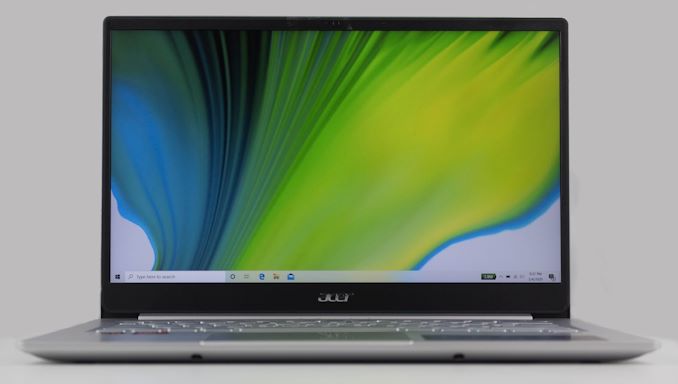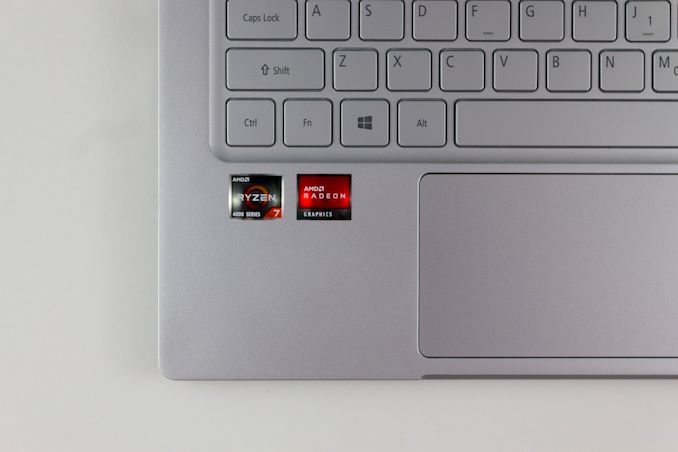The Acer Swift 3 SF314 Notebook Review: Swift Gets Swifter With Ryzen 4000
by Brett Howse & Andrei Frumusanu on May 5, 2020 8:00 AM EST
Almost two years ago to the day, we had a chance to check out Acer’s Swift 3 laptop featuring AMD's first Ryzen Mobile platform, Raven Ridge. Acer has been a strong partner for AMD, generally being one of the first out of the gate with new designs featuring AMD’s latest platforms, and this year that partnership has played out again. Today we are taking a look at the newest AMD APU offering, the Ryzen 4000 "Renoir", which is at the heart of Acer’s latest iteration of the 14-inch Swift 3. With a brand-new AMD processor and some innovations in the Swift 3 design itself, both AMD and Acer have made some tremendous improvements for 2020.
Ryzen 7 4700U
The big news for 2020 is AMD’s new APU platform, codenamed Renoir. Selling as the Ryzen 4000 series, these new APUs bring a number of major updates to AMD's platform, as the company further sands down the rough edges from the Ryzen 3000 Picasso series. Key to this is a much-needed jump from GlobalFoundries' 12nm process to TSMC's class-leading 7nm process, giving AMD a much-wanted boost in transistor performance and overall energy efficiency. Coupled with a number of further optimizations at the chip and driver level, and AMD's latest APUs are proving far better suited for thin-and-light mobile designs than their predecessors.
Under the hood, like AMD's desktop processors introduced last year, the new Ryzen 4000 series APUs are the first laptop-focused products from AMD which feature their Zen 2 CPU cores. Designed hand-in-hand with TSMC's 7nm process, the Zen 2 architecture has further boosted AMD's performance across both IPC and clockspeeds, and the small cores have allowed AMD to get away with 8 of them in even a laptop APU. Meanwhile the iGPU is based on the same Vega architecture graphics as both the 2000-series and 3000-series APUs, but in a new configuration. Thanks to TSMC’s 7nm process, AMD has been able to crank up the GPU frequency much higher than before – so much higher that they’ve actually scaled back on the number of GPU compute units, while still promising improved GPU performance over the previous generation of APUs.
Ian had a chance to take the new Ryzen 4000 platform for a spin in early April, although that sample was the 45-Watt H series. Many of the concepts carry across though, so if you’ve not yet had a chance to catch up on Renoir, be sure to check out the Ryzen 9 4900HS review. The 45-Watt processor range is pretty much the standard in high-performance notebooks, but the vast majority of laptops on the market stick to the lower-powered 15-Watt range, which is what we have in the Acer Swift 3.
Acer has opted for what is likely to be one of the most popular SKUs in the AMD Ryzen 4000 range, the Ryzen 7 4700U. AMD has gone a very non-traditional route for this part, offering eight physical CPU cores, but disabling simultaneous multithreading (SMT). All of AMD’s H-Series lineup of 45-Watt processors do offer SMT, but only two of the new U-Series provide this, with the Ryzen 5 4600U offering 6 cores and 12 threads, and the Ryzen 7 4800U providing 8 cores and 16 threads, all in the 15-Watt thermal design power (TDP) that is so common on laptops. In the typical 15-Watt laptop space, AMD is the first to offer 8 cores, just not always with SMT.
On the GPU side, the Ryzen 7 4700U offers 7 Vega-architecture Compute Units (CUs), with a maximum clockspeed of 1600 MHz. Compared to the previous generation Ryzen 7 3700U, the GPU drops three compute units, but bumps the maximum frequency from 1300 MHz to 1600 MHz, so we shall see where this plays out in terms of performance.
The Acer Swift 3
Acer has managed to bundle a lot of product into the Swift 3. The 14-inch notebook features a 1920x1080 IPS display that, albeit lacking touch support, does get showcased well thanks to the Swift 3's thin bezel surround. The laptop ships with 8 GB of DDR4-3200, and though we would have loved to see LPDDR4X, the capacity is what is important here, and 8 GB is a good amount for a budget-friendly laptop like the Swift 3. Also, Acer has managed to outfit this notebook with a 512 GB SSD, which is fantastic. They will also be offering a less-expensive version with a Ryzen 5 4500U, 8 GB of RAM, and a 256 GB SSD.
| Acer Swift 3 SF314-42 | |||||
| Ryzen 5 | Ryzen 7 Model Reviewed |
||||
| CPU | AMD Ryzen 5 4500U 6 core 6 thread 2.3-4.0 GHz 2x 4MB L3 15W TDP |
AMD Ryzen 7 4700U 8 core 8 thread 2.0-4.1 GHz 2x 4MB L3 15W TDP |
|||
| GPU | AMD Vega 6 6 CUs 1500MHz Boost |
AMD Vega 7 7 CUs 1600MHz Boost |
|||
| RAM | 8 GB Dual-Channel DDR4-3200 | ||||
| Storage | 256 GB PCIe NVMe SSD | 512 GB PCIe NVMe SSD | |||
| Display | 14-inch 1920x1080 IPS | ||||
| Networking | Intel Wi-Fi 6 AX200 2x2:2 802.11ax Bluetooth 5.0 |
||||
| Audio | Stereo Speakers DTS Sound |
||||
| Battery | 48 Wh Li-Ion 65-Watt Charger (barrel connector) USB Power Delivery Support |
||||
| Right Side | USB 2.0 x 1 Headset jack Battery Charge Indicator |
||||
| Left Side | USB 3.2 Gen 1 x 1 with power-off charging USB 3.2 Gen 2 Type-C w/DisplayPort, PD HDMI 2.0 Charging connector |
||||
| Dimensions | 323.4 x 218.9 x 15.95 mm 12.73 x 8.62 x 0.63 inches |
||||
| Weight | 1.2 kg / 2.65 lbs | ||||
| Camera | 720p Super High Dynamic Range | ||||
| Extras | Fingerprint Reader | ||||
| Price (MSRP) | $629 USD | $649 USD | |||
Despite the strong APU, RAM, and storage offerings, Acer is not done there. The Swift 3 also features Wi-Fi 6 thanks to Intel’s AX200 wireless adapter, which means 2.4/5.0 GHz wireless support with 160 Mhz channels if your router is has the correct capabilities. There’s also an integrated fingerprint reader for Windows Hello Support, and the entire package is contained in an all-aluminum chassis which weighs just 1.2 kg / 2.65 lbs. Considering the $649 MSRP, this is an incredible value.











191 Comments
View All Comments
Spunjji - Wednesday, May 6, 2020 - link
Deicidium doesn't care that the benchmarks invalidate his talking points. As long as Intel only have 4 cores at 15W, 4 cores will be enough. Once Intel get 8 cores at 15W, he'll find a reason why it suddenly makes sense.SolarBear28 - Tuesday, May 5, 2020 - link
Regardless of whether or not 8 cores is necessary in a budget device, I think its a good policy to get as much CPU as you can for the money, especially in a non upgradable laptop. I have a usable 10 year old laptop because I got more CPU power than i needed at the time of purchase.Spunjji - Wednesday, May 6, 2020 - link
This. If you're keeping a device for more than 4 years, you're buying for the software made then, not now.0iron - Thursday, May 7, 2020 - link
I wish I could give 👍 to your comment!sonny73n - Tuesday, May 5, 2020 - link
@deici“ The extra cores are useless and nothing more than a marketing exercise - no one using this laptop will be doing anything that even requires 4 cores. ”
I open 15 tabs on average with web browser(s). I also transcode movies very frequently. So the more cores the better. We know you’re full of BS, Intel shill.
Dribble - Thursday, May 7, 2020 - link
Having millions of tabs open doesn't require lots of cores, just enough memory. You aren't going to be transcoding movies on a cheap laptop with a little SSD.sonny73n - Thursday, May 7, 2020 - link
@DribbleObviously you’ve never worked with browsers before. More cores is better for multitasking but someone on here said otherwise.
Yes, I’m transcoding a few Disney movies every week for my 4 years old son so he can watch them with his iPad.
I’m not going to explain to you in technical details. If you think “the extra cores are useless...” like Deici does, you’re totally in a different league.
Spunjji - Wednesday, May 6, 2020 - link
"The extra cores are useless and nothing more than a marketing exercise"Maybe, maybe not. Not really your place to say how other people are supposed to use their laptops, is it?
Bear in mind that we only got 4 cores at 15W from Intel *after* AMD announced the original Ryzen APU. Your logic now sounds like theirs when they designed Kaby Lake.
GreenReaper - Thursday, May 7, 2020 - link
Browser tabs, virus checkers, malware, that stream you have going in the corner on your secondary monitor - all of those things take up cores. A lot of software has been redeveloped to use all the cores available to it nowadays.fmcjw - Tuesday, May 5, 2020 - link
Is it because the 8-core throttles more to an even lower power state, spending more time to cool down?I'm also curious to see evaluations of how much of that 25% battery time is consumed by wasted cycles in actual application performance. Probably not a lot on a benchmarks, since the SoC is designed to be shut down idle cores, but in real life the OS probably fires them up for no good reason, probably just because they they're there. I mean this is a mix of apps with legacy UI's and libraries we're talking about, not server optimized cloud applications.
Accordingly, from a software and sustained performance perspective, is it better just to focus on single core performance?
I have a tendency to get a more predictable Core i3-8145U sans Turbo Boost, or a Ryzen 3-3200U with fewer cores, despite them looking poor on benchmarks. I have no idea what I'm missing, but hopefully it's a worthy trade-off. At least there's less throttling due to quicker heat up of quad/hex/octa-cores, longer battery life due to less cores to address, and wasted cycles due to inefficiencies in the application/OS.
Hope this is something Anandtech can investigate? Too many brilliant minds are trained on phone topics, but not the state of affairs in PC land.